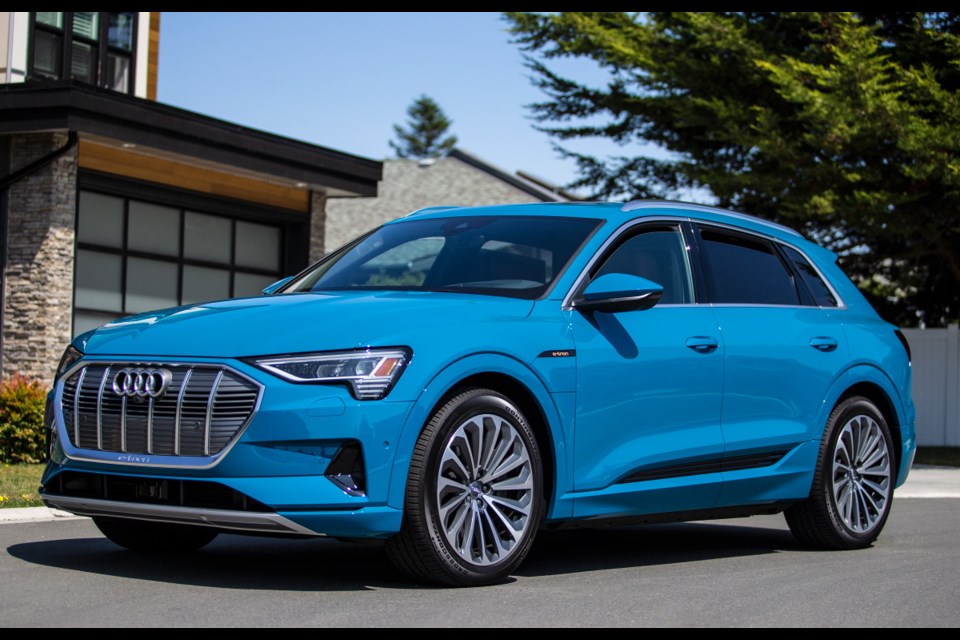AudiŌĆÖs ambitions plan to develop and deliver 12┬Ābattery-electric vehicles to customers in the next seven years starts with the 2019 55 quattro e-tron (lower case ŌĆ£eŌĆØ), their first all-electric SUV.
If you are thinking you heard that name before, you are not mistaken ŌĆö they used to sell the A3 Sportback e-tron.
AudiŌĆÖs global plan to transition to emission-free mobility means offering a full range of electrified vehicles, from SUVs to small city cars (Europe only) in just seven years.
Wow.
The previous A3 e-tron, introduced in 2015, was Audi dipping its toes into the segment, with a plug-in hybrid-electric vehicle that sported a 8.8-kWh battery and a 50-kilometre all-electric range.
TodayŌĆÖs 55 quattro e-tron has a 95-kWh battery and a range of 329 km, and capable of 150 kW DC fast-charging to boot.
There is one model with two trim levels, the Progressiv at $90,000 and the Technik, which starts at $98,000. I drove the latter.
When you approach the e-tron for the first time, you get the immediate sense that this is an Audi first and a new battery electric vehicle (BEV) second. There are no futuristic design elements to set it apart from other SUVs on the road.
The only cosmetic giveaway is a silver grille and a charge port on the fender. Of note is that Audi is the first manufacturer to give customers the option of choosing the side of the car on which they want the charge port to reside.
Size-wise, the e-tron fits in between the current Q5 and Q8, and holds five occupants.
Comparable BEVs in this premium segment include the Tesla Model X, the Jaguar I-Pace and the upcoming Mercedes-Benz EQC.
Of the three, the I-Pace is the closest to the e-tron. The Model X is larger and can hold up to seven, and the EQC is smaller overall.
Between the I-Pace and the e-tron, the latter offers rear passengers more headroom, legroom and cargo capacity due to the formerŌĆÖs more sloping roof.
As a vehicle conceived as an electric vehicle from the start, there is no transmission tunnel necessary. This space is used to swallow coffee thermoses in the front and extra legroom for the middle passenger in the rear (although the rear climate controls intrude).
There are two electric motors, one to each axle, producing 300 kilowatts of power. That translates to 355 horsepower (or 402 hp temporarily in Boost Mode) and 490 pound-feet of torque. Audi claims a 0-96 km/h sprint in 5.7 seconds.
Although the e-tron is all-wheel drive, it delivers that feature differently from conventional vehicles. The front and rear motors act independently and in tandem. Sensors on each wheel determine slippage and redistribute torque as needed.
Under normal driving conditions and highest efficiency, the e-tron only uses its rear motor ŌĆö the front only comes into play when extra power or traction is called for.
This rear bias, coupled with a low centre of gravity and an almost 50/50 weight balance, gives the e-tron a level of engagement that enthusiasts crave.
But take it on a side road and the e-tron behaves like a willing partner in a fast dance.
With no internal-combustion engine noise, travel on the highway is serene, with minimal wind and road noise making their way into the cabin.
The e-tron also has a standard air suspension and adaptive shock absorbers. It can vary its ride height by as much as 76 millimetres. There are five user-selectible ride heights ŌĆö to raise it when encountering obstacles, for example. The vehicle will automatically lower itself on the highway to optimize aerodynamics.
Audi says it is the first manufacturer to offer an electro-hydraulic braking system in a series production vehicle with electric drive (the first application in an internal combustion-engined vehicle was the 2001 Mercedes-Benz SL-Class).
Unlike a conventional servo-assisted hydraulic system, which uses a vacuum booster, the electro-hydraulic braking system uses hydraulic pumps instead.
The system gives more precise control of braking at each wheel, and also integrates well with regenerative braking in electric cars.
With a list price starting at $90,000, it is a safe bet that the e-tron is first and foremost a luxury vehicle ŌĆö and you will not be disappointed.
The e-tron features AudiŌĆÖs typical attention to detail, with exquisite fit and finish applied to all the materials in the cabin.
The cabinŌĆÖs overall design is clean and functional, with materials that will delight the touch.
Technology abounds, with a reconfigurable digital screen (Audi calls it the Virtual Cockpit) that replaces the conventional instrument cluster as well as two screens (a 10.1-inch stacked on top of a 8.8-inch) that take care of the infotainment system and climate control.
The traditional gear shifter has been replaced by a square controller that you turn to engage drive, reverse and park. Other manufacturers use a round knob, but there is no rule that says you canŌĆÖt use a square knob to do the same job.
If the 2019 Audi 55 quattro e-tron is just the first of a new generation of eclectic vehicles, the future is looking bright for this manufacturer - and consumers.
THE SPEC SHEET
Type: Luxury battery-electric SUV, dual engine, all-wheel-drive
Engines: Two electric motors with a combined 300 kW (355 hp regular and 405 hp in Boost Mode) and 664 Nm (489.7 lb.-ft. of torque)
Battery: 95 kWh lithium-ion
Charging times: 240V@10 hours; 400V@1 hour
Range (km): 329
Transmission: One speed
Dimensions (mm): Length, 4,901; width, 1,935; height, 1,616; wheelbase, 2,928
Curb weight (kg): 2,490
Price (base/as tested): $98,000/ $109,495 (includes $2,895 freight and PDI and $100 AC tax)
Options: Driver Assistance package $2,800, Luxury package $4,500, 21-inch wheels and 265/45 R21 tires $1,200
Tires: 255/50 R20 on alloy wheels
Fuel type: Electricity
Fuel economy (Litres equivilent/100km): 3.2 city and highway
Warranty: Four years/80,000 km new car



